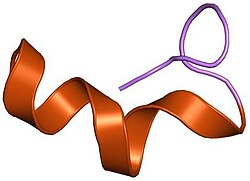| EDN1 |
|---|
 |
| Available structures |
|---|
| PDB | Ortholog search: PDBe RCSB |
|---|
| List of PDB id codes |
|---|
1EDN, 1EDP, 1T7H, 1V6R, 6DK5, 5GLH |
|
|
| Identifiers |
|---|
| Aliases | EDN1, ARCND3, ET1, HDLCQ7, QME, endothelin 1, PPET1 |
|---|
| External IDs | MGI: 95283; HomoloGene: 1476; GeneCards: EDN1; OMA:EDN1 - orthologs |
|---|
| Gene location (Human) |
|---|
 | | Chr. | Chromosome 6 (human)[1] |
|---|
| | Band | 6p24.1 | Start | 12,290,361 bp[1] |
|---|
| End | 12,297,194 bp[1] |
|---|
|
| Gene location (Mouse) |
|---|
 | | Chr. | Chromosome 13 (mouse)[2] |
|---|
| | Band | 13 A4|13 20.82 cM | Start | 42,454,952 bp[2] |
|---|
| End | 42,461,466 bp[2] |
|---|
|
| RNA expression pattern |
|---|
| Bgee | | Human | Mouse (ortholog) |
|---|
| Top expressed in | - lower lobe of lung
- right lung
- subcutaneous adipose tissue
- upper lobe of left lung
- human penis
- islet of Langerhans
- tibial nerve
- rectum
- Achilles tendon
- gallbladder
|
| | Top expressed in | - pharynx
- right lung lobe
- left colon
- vascular endothelium
- left lung lobe
- external carotid artery
- internal carotid artery
- endoderm
- lip
- carotid body
|
| | More reference expression data |
|
|---|
| BioGPS |  | | More reference expression data |
|
|---|
|
| Gene ontology |
|---|
| Molecular function | - hormone activity
- signaling receptor binding
- cytokine activity
- endothelin B receptor binding
- protein binding
- endothelin A receptor binding
| | Cellular component | - cytoplasm
- Weibel-Palade body
- basal part of cell
- extracellular region
- rough endoplasmic reticulum lumen
- extracellular space
- transport vesicle
| | Biological process | | | Sources:Amigo / QuickGO |
|
| Orthologs |
|---|
| Species | Human | Mouse |
|---|
| Entrez | | |
|---|
| Ensembl | | |
|---|
| UniProt | | |
|---|
| RefSeq (mRNA) | | |
|---|
| RefSeq (protein) | |
|---|
NP_001161791
NP_001946
NP_001161791
NP_001946 |
| |
|---|
| Location (UCSC) | Chr 6: 12.29 – 12.3 Mb | Chr 13: 42.45 – 42.46 Mb |
|---|
| PubMed search | [3] | [4] |
|---|
|
| Wikidata |
| View/Edit Human | View/Edit Mouse |
|
Endothelin 1 (ET-1), also known as preproendothelin-1 (PPET1), is a potent vasoconstrictor peptide produced by vascular endothelial cells.[5] The protein encoded by this gene – EDN1 – is proteolytically processed to release endothelin 1. Endothelin 1 is one of three isoforms of human endothelin.
Sources
Preproendothelin is precursor of the peptide ET-1. Endothelial cells convert preproendothelin to proendothelin and subsequently to mature endothelin, which the cells release.[5][6]
Clinical significance
Endothelin-1 receptor antagonists (Bosentan) are used in the treatment of pulmonary hypertension.[5] Use of these antagonists prevents pulmonary arterial constriction and thus inhibits pulmonary hypertension.[5]
As of 2020, the role of endothelin-1 in affecting lipid metabolism and insulin resistance in obesity mechanisms was under clinical research.[7]
References
- ^ a b c GRCh38: Ensembl release 89: ENSG00000078401 – Ensembl, May 2017
- ^ a b c GRCm38: Ensembl release 89: ENSMUSG00000021367 – Ensembl, May 2017
- ^ "Human PubMed Reference:". National Center for Biotechnology Information, U.S. National Library of Medicine.
- ^ "Mouse PubMed Reference:". National Center for Biotechnology Information, U.S. National Library of Medicine.
- ^ a b c d Davenport AP, Hyndman KA, Dhaun N, Southan C, Kohan DE, Pollock JS, et al. (April 2016). "Endothelin". Pharmacological Reviews. 68 (2): 357–418. doi:10.1124/pr.115.011833. PMC 4815360. PMID 26956245.
- ^ Boulpaep EL, Boron WF (2009). Medical physiology: a cellular and molecular approach. Saunders/Elsevier. ISBN 978-1-4160-3115-4.
- ^ Jenkins HN, Rivera-Gonzalez O, Gibert Y, Speed JS (December 2020). "Endothelin-1 in the pathophysiology of obesity and insulin resistance". Obesity Reviews. 21 (12): e13086. doi:10.1111/obr.13086. PMC 7669671. PMID 32627269.
External links
- Overview of all the structural information available in the PDB for UniProt: P05305 (Endothelin-1) at the PDBe-KB.
This article incorporates text from the United States National Library of Medicine, which is in the public domain.



















